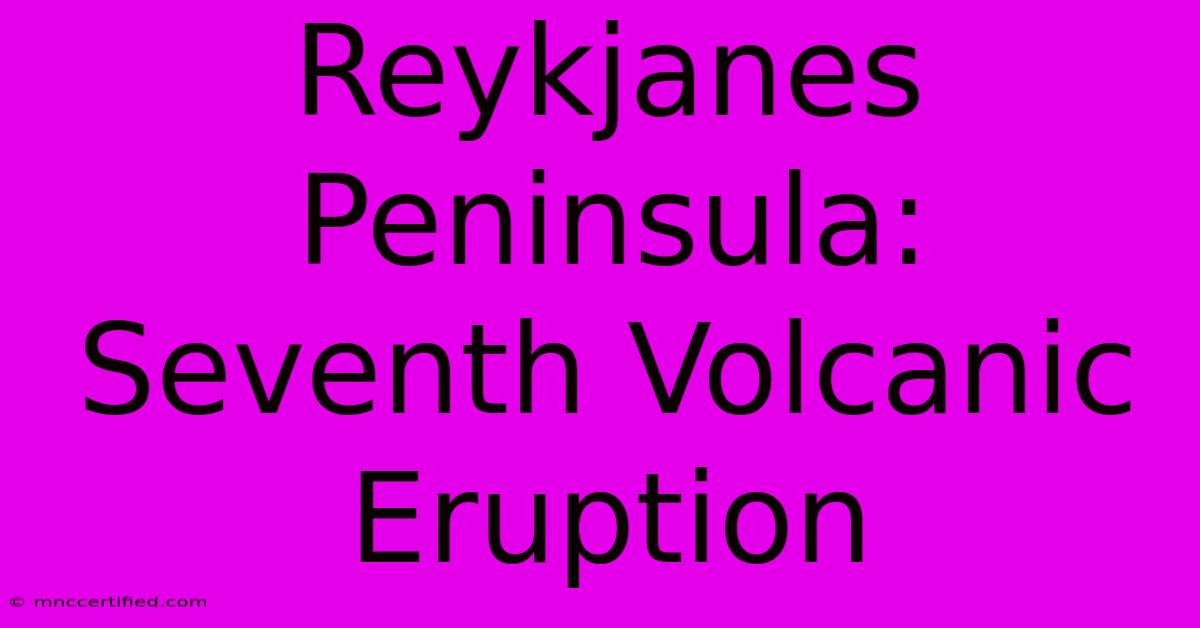Reykjanes Peninsula: Seventh Volcanic Eruption

Table of Contents
Reykjanes Peninsula: Seventh Volcanic Eruption and What it Means for Iceland
The Reykjanes Peninsula, a geologically active region in southwest Iceland, has once again captured global attention with its seventh volcanic eruption since March 2021. This recent event, while spectacular, underscores the peninsula's dynamic nature and the ongoing geological processes shaping Iceland. This article delves into the details of this latest eruption, its impact, and what it signifies for the future of volcanic activity in the area.
Understanding the Reykjanes Peninsula's Volcanic Activity
The Reykjanes Peninsula sits atop the Mid-Atlantic Ridge, where the North American and Eurasian tectonic plates meet. This boundary is a hotspot of geological activity, resulting in frequent earthquakes and volcanic eruptions. The current eruption cycle, beginning in March 2021, is unprecedented in recent history, marking a significant shift in volcanic behavior on the peninsula. Previous eruptions were infrequent, often separated by centuries, making this recent cluster of events a fascinating and somewhat unpredictable phenomenon for volcanologists.
The Significance of the Seventh Eruption
The seventh eruption, while visually stunning, is particularly noteworthy for several reasons:
- Increased Frequency: The close proximity of these eruptions suggests a potential shift in the magma supply system beneath the peninsula. Further research is needed to fully understand this change and its long-term implications.
- Predictability Challenges: While scientists are improving their ability to predict volcanic eruptions, the rapid succession of events on the Reykjanes Peninsula highlights the inherent challenges in accurately forecasting volcanic activity, especially in such a dynamic environment.
- Tourism and Infrastructure: The eruptions, while generally considered relatively small and effusive (meaning lava flows rather than explosive blasts), still pose risks to infrastructure and tourism. Authorities continue to monitor the situation closely and implement safety measures to protect both people and property. The accessibility of the eruption sites also plays a crucial role in how the events are managed.
The Impact of the Eruptions
The ongoing volcanic activity on the Reykjanes Peninsula has had a multi-faceted impact:
- Environmental Changes: The lava flows reshape the landscape, creating new land formations and altering existing ecosystems. The release of volcanic gases can also impact air quality in the surrounding areas.
- Tourism Boom: Despite the inherent risks, the eruptions have attracted a significant influx of tourists eager to witness the raw power of nature. This has boosted the local economy but also places a strain on infrastructure and requires careful management of visitor safety.
- Scientific Advancements: Each eruption provides invaluable data for volcanologists, enhancing our understanding of volcanic processes and improving predictive capabilities. The opportunity for real-time observation and data collection is unparalleled.
What the Future Holds
Predicting future volcanic activity on the Reykjanes Peninsula remains challenging. However, based on current trends, it's likely that volcanic eruptions will continue in the coming years. Scientists are closely monitoring seismic activity, ground deformation, and gas emissions to better understand the magma dynamics and potentially forecast future events. Continuous monitoring and research are crucial to mitigate risks and ensure the safety of both residents and visitors.
Conclusion: A Dynamic Landscape
The Reykjanes Peninsula's seventh volcanic eruption is a testament to the dynamic geological processes shaping Iceland. While the eruptions pose challenges, they also offer unique opportunities for scientific advancement and economic development. By combining scientific monitoring, responsible tourism management, and effective risk mitigation strategies, Iceland can harness the potential of this active volcanic region while ensuring the safety and well-being of its population and visitors. The ongoing saga of the Reykjanes Peninsula eruptions will undoubtedly continue to fascinate and inform for years to come.
Keywords: Reykjanes Peninsula, volcanic eruption, Iceland, Mid-Atlantic Ridge, tectonic plates, volcanology, tourism, geological activity, magma, lava flows, earthquake, risk mitigation, scientific research, environmental impact.

Thank you for visiting our website wich cover about Reykjanes Peninsula: Seventh Volcanic Eruption. We hope the information provided has been useful to you. Feel free to contact us if you have any questions or need further assistance. See you next time and dont miss to bookmark.
Featured Posts
-
Ground Beef Recall 160 000 Pounds
Nov 22, 2024
-
Snowflake Stock Jumps Revenue Beats Estimates
Nov 22, 2024
-
Premier Capital Investment Group
Nov 22, 2024
-
Arsenal 1 0 Juventus Champions League
Nov 22, 2024
-
Investment Firms In Philadelphia
Nov 22, 2024